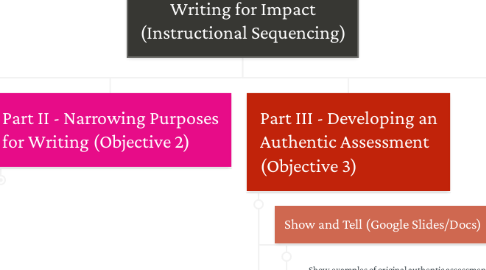
1. Part I - Introduction and Context (Objective 1)
1.1. Google Slides Presentation
1.1.1. Video Testimonials
1.1.2. Concepts and Definitions
1.2. Mnemonics
1.2.1. GRASPS (Wiggins and McTighe)
1.2.2. RAFTS
1.3. Graphic Organizer
1.3.1. Concept Mapping
1.3.2. Departmental Definition
2. Part II - Narrowing Purposes for Writing (Objective 2)
2.1. Crowdstorming
2.1.1. Traditional Writing Assessments
2.1.2. Real-World Writing Assessments
2.2. Brainstorming
2.2.1. Possible Audiences for Writing
2.2.2. Possible Purposes for Writing
2.3. Develop Real-World Purposes
2.3.1. Employee
2.3.2. Employee
3. Part III - Developing an Authentic Assessment (Objective 3)
3.1. Show and Tell (Google Slides/Docs)
3.1.1. Show examples of original authentic assessments
3.1.2. Show examples of writing assessments that have been revised for greater authenticity
3.2. Quick Writes (Google Slides/Docs)
3.2.1. Respond to quick prompts using authentic formats - ad slogan, product review, professional email
3.2.2. Reverse-engineer instructions for students to complete these assignments based on what we discuss and need to know to do them
3.3. Faded Prompts (Google Slides/Docs)
3.3.1. Use a partially-filled in chart to create authentic assessments as scaffolding.
3.3.2. Develop an original assessment from scratch.
3.3.2.1. Develop instructions/delivery method for this assignment. (It is helpful for the delivery method to somewhat match the tone or format of the intended assignment.)
3.4. Transfer/Extension Opportunity
3.4.1. Use Flipgrid to upload feedback for instructor, classmates, thoughts on authentic assessment, and/or reviews of others' assessments.
3.4.1.1. Users can see and comment on others' feedback.
4. Part IV - Rubrics and Grading Tools
4.1. (Digital) Gallery Walk
4.1.1. Post authentic assessments around the room
4.1.2. Use Aurasma's augmented reality app to post independent feedback
4.2. Troubleshooting
4.2.1. Compile feedback into Google Docs that focus on common themes, issues, problems
4.2.2. Anticipate issues students may experience with tackling authentic assessments
4.3. Rubric Template
4.3.1. Use issues and anticipated problems to address misconceptions about authentic assessments for students
4.3.2. Design rubric using category weights for purpose, audience, format, and tone

